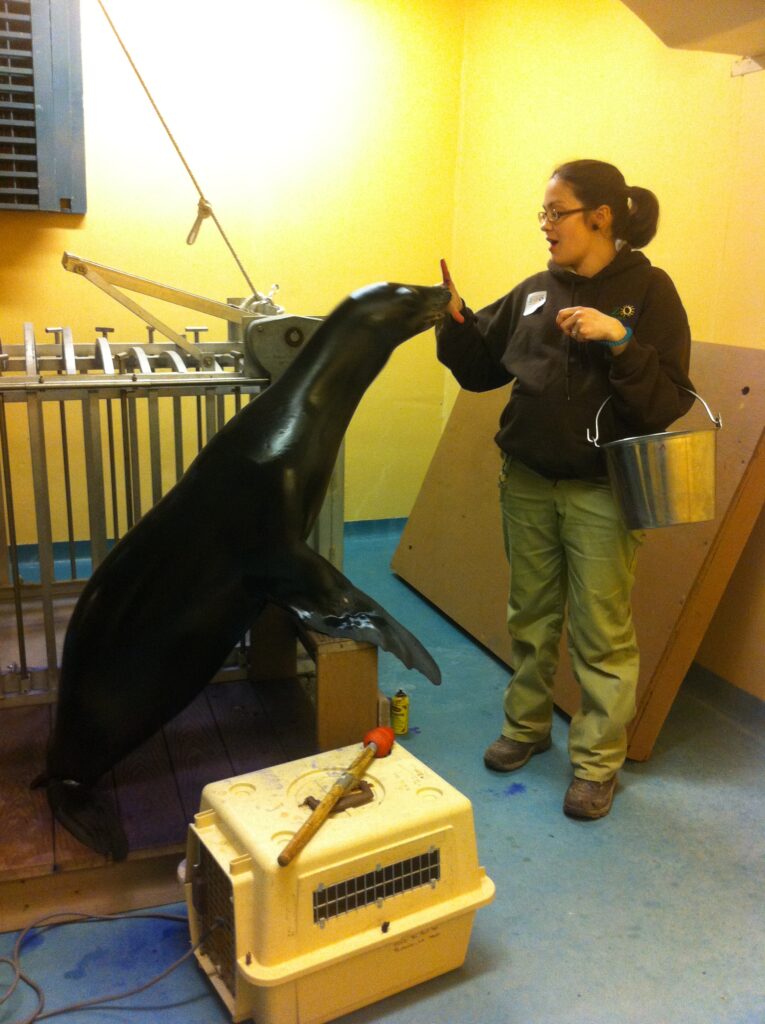 If you ask me, the best part of our jobs as zoo keepers is the opportunity to participate in positive reinforcement training. Most of the animals you see at the Zoo, from the tiny golden lion tamarins, to the great African lions, participate in training on a regular basis. When training with positive reinforcement, a trainer relies on motivating an animal through rewards rather than with force or coercion.
If you ask me, the best part of our jobs as zoo keepers is the opportunity to participate in positive reinforcement training. Most of the animals you see at the Zoo, from the tiny golden lion tamarins, to the great African lions, participate in training on a regular basis. When training with positive reinforcement, a trainer relies on motivating an animal through rewards rather than with force or coercion.
Animal training has a profound impact on our animals’ physical, emotional and mental welfare. The vast majority of behaviors we train are used to aid animal health efforts. We train our animals to stand on a scale to be weighed, voluntarily accept injections, give blood and offer body parts for keepers and vets to examine. Many animals voluntarily enter a crate to be transported to the animal hospital, eliminating the need to chase and capture them. This not only makes the whole experience more enjoyable for the animal, but it helps the vet get a clear view of the animal’s health by providing normal readings rather than the elevated heart rate, temperature and stress hormones they find in animals that had to be netted or chased.
The benefits of animal training go much further than its effects on physical health. Training is an amazing way of exercising an animal’s mind. Essentially, when an animal is taught a new behavior, it is solving a puzzle. For example, which behaviors will earn me a treat? Solving problems to find food is a natural behavior and an important part of life for most animals. For an animal and trainer that know each other well, the animal is helping to solve the puzzle through subtle communication from the trainer. In a process called shaping, the trainer will reward behaviors that look more and more like the desired behavior. Through the process, the animal tries new things as if to say, “Is this what you want? How about this?” and is answered by the trainer’s patient waiting or quick reward. Together, they play a game of hot and cold until the right behavior is reached. At this moment, it is not uncommon to find both trainer and animal elated, each seeming to think, “We did it!” This moment of triumph keeps the animals coming back for more and it seems to give the animal as much joy as the trainer. Just watch Lou the hyena bound and spin in joyful circles the next time he sees one of his trainers. When taught to do a behavior on cue, these animals are empowered with ways to earn their food. Far from seeming defeated or subservient, these animals tend to put on an air of empowerment and eagerness to engage. Positive reinforcement trainers the world over report a permanent change in their animals as they become more bold and creative after participation in training.
By teaching the animals through patience, rewards and relationship, along with such creeds as “it’s never the animal’s fault” and “make the right behavior easier,” both trainer and animal are enriched and enjoy cross-species communication as well as continually unfolding new opportunities. Every day I feel grateful to not only work with, but communicate and reach goals with the wonderful residents of the Seneca Park Zoo.
Laura Shipp, Zoo Keeper and Co-Chair of the Zoo’s Animal Training Committee
Photos by Mary Ellen Ostrander & Kelli O’Brien

